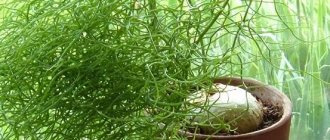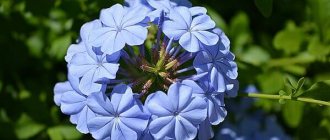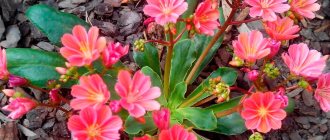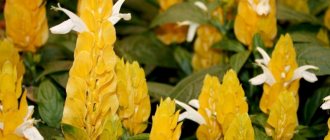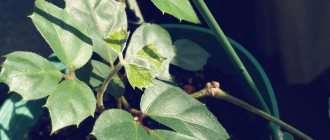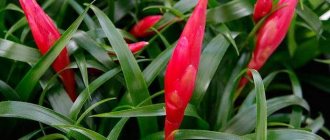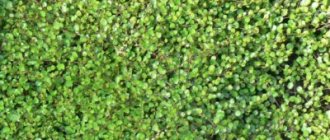What does Echinocactus Gruzoni look like?
Echinocactus grusonii has the shape of an almost regular ball. It is very popular among flower growers. The plant, as you might guess, belongs to the extensive Cactaceae family. Distributed in North and Central America, mainly in Mexico and the southern states of the United States, preferring arid lowland climates.
In nature, the echinocactus Gruzoni successfully survives in hot, arid climates
The genus Echinocactus, which unites the six most common spherical cacti in this territory, received its name due to its characteristic shape and the presence of long, sharp spines of pale golden or amber color, beautifully contrasting with the overall dark green background. Translated from Greek “echinus” means sea urchin. The plant really resembles a bristling hedgehog curled up in a ball. As you grow older (13–15 years), the “ball” stretches a little vertically. Because of this, the plant has earned the nickname “golden barrel”. There are other names of folk origin - “mother-in-law’s chair (or pillow)”, “bedside table”, “golden ball”.
This particular species was named in honor of Hermann August Gruson, an innovator, inventor and major entrepreneur who lived in Germany in the 19th century. In addition to his main activity, he was also interested in botany and collected one of the largest collections of cacti in Europe for its time. They then donated it to their hometown, Magdeburg, along with greenhouses specially designed for their cultivation.
Hermann August Gruson - successful German industrialist and inventor, as well as a passionate cactus lover
When the first of the Gruzoni echinocacti was discovered in 1891 by the German researcher Heinrich Hildmann, he remembered his compatriot “fan” and immortalized his name.
In nature, these are real giants. The diameter of the stem on average reaches 1.5–2 m. But there are also real “record holders” - 3 m or more. At home, everything is much more modest. Most specimens do not exceed 40–50 cm in diameter.
At home, an adult echinocactus Gruzoni rarely exceeds the diameter of a watermelon, but in nature it is much larger
Echinocactus Gruzoni is densely covered with sharp spines, straight or slightly curved. Those growing closer to the center reach 4–5 cm in length, those located on the periphery - 2–3 cm. At the top, the spines intersect. Thick “stubble” fits into the norm there.
The spines of the Echinocactus Gruzoni stand out impressively against the general dark green background
The correct rounded shape is “supported” by many ribs. On average, their number is 35–45 pieces. Echinocactus Gruzoni does not form side shoots or “children”. It is always a large single plant.
It blooms very rarely at home. Even in nature, only mature specimens that have reached the age of 20 years or older form buds. Flowering occurs in spring. Single buds bloom alternately at the top of the plant. The flowers look like pale yellow or yellowish-brown bells, 5–6 cm in diameter. Then oblong fruits, covered with short whitish “lint,” ripen.
Blooming echinocactus Gruzoni at home is a truly exclusive sight
Like all cacti, this is a real long-liver. A hundred years for him (subject to proper care) is far from the limit. There are known plants whose age is estimated at 500–600 years. During this time, the echinocactus Gruzoni reaches a significant mass (several tons). Therefore, when a plant suddenly begins to absorb moisture during the rainy season, it often turns over under the weight of its own above-ground part, lying on its side. But it most likely will not die, forming new roots.
Echinocactus Gruzoni is a natural “conductor”. Weak electrical discharges constantly pass through its needles. Some scientists believe that in this way the plant “pumps” water from the roots to the crown.
Under natural conditions, the echinocactus Gruzoni, like a sunflower, reaches towards the sun, tilting slightly in search of warmth. Accordingly, the opposite side wrinkles, as if “deflated.” The difference is quite noticeable. If you do not want to create an authentic Mexican landscape in your apartment, regularly rotate the pot while maintaining the direction (clockwise or counterclockwise).
Video: appearance of Echinocactus Gruzoni
Echinocactus flowering
Echinocactus grusona will reward only very patient gardeners with flowering. After all, the maturity of a cactus in the form of the ability to reproduce and form seeds occurs at the age of 20 years. And even after such a long time, under unfavorable conditions, buds may not appear.
Advice! If you buy an adult specimen and care for it properly, you will be able to see flowers earlier.
The appearance of protrusions on the top of the ball indicates the upcoming flowering. Funnel-shaped buds bloom from them; the color depends on the species.
Gruzoni are characterized by bright yellow flowers with thin and elongated petals, they are located around the circumference of the flattened top.
View this post on Instagram
Posted by Tamara Vouk (@vouktamara) Mar 13, 2021 at 12:46 pm PDT
Types grown at home
All Gruzoni echinocacti are quite large plants. Therefore, the possibility of growing them at home is often limited by the area of the grower’s apartment. If there is no such problem, you can safely purchase any breeding hybrid you find, or the “classic” version.
You can often find Gruzoni echinocacti on sale with neon pink, scarlet, bright yellow, and lilac spines. This is not the latest achievement of breeders, but the result of using a solution of ordinary food coloring instead of water for irrigation. If the buyer stops this practice, the shade of the thorns will quickly return to normal.
Multi-colored echinocacti Gruzoni are not a new breeding variety, but a simple trick for indoor plant growers
Most often found at home:
- Echinocactus Gruzoni Texas (texensis). The plant is spherical in shape, about 30 cm in diameter, slightly flattened on the sides. Height - no more than 15-20 cm. There are relatively few ribs - 15-25. Now, from a scientific point of view, this plant does not belong to echinocacti. According to recent changes in taxonomy, it is classified in the genus Homalocephalus. Even against the background of other “relatives” it stands out for its unpretentiousness.
- Echinocactus Gruzoni white-spined (albispinus). Selective hybrid. Sometimes thought to be a mutation that spontaneously arose in nurseries. It differs from the “parent” by the presence of snow-white spines. If the plant stands in direct sunlight for a long time, they gradually change their shade to sand or bronze, acquiring a kind of “tan.” At the same time, new spines grow white - a very interesting contrast is created.
- Echinocactus Gruzoni setispinus. It is distinguished by the presence of very thin, long (up to 7 cm) spines, more like hairs. As the plant matures, they lengthen further. An adult plant seems to be shrouded in a cobweb.
- Echinocactus Gruzoni thornless (subinermis). It still has spines, but they are very short, no more than 1 cm long. There are no other differences from the “classic” version.
- Echinocactus Gruzoni crested (cristatus). Rarely found at home. It is distinguished by the presence of curved yellow-white spines of an interesting shape.
- Rare Echinocactus Gruzoni (monstruosus). The spines are very short. There is yellow-white pubescence on the top of the head.
- Echinocactus Gruzoni variegatus. Yellow and/or lime spots stand out effectively against the general dark green background of the stem.
Photo gallery: varieties of Echinocactus Gruzoni popular among amateur gardeners
Echinocactus Gruzoni Texas currently no longer belongs to this genus
Echinocactus Gruzoni white-spined - a spontaneous natural mutation
The echinocactus Gruzoni setae has very thin spines that are soft to the touch.
Echinocactus Gruzoni spineless as if just shaved
Echinocactus Gruzoni comb looks very unusual
The rare Echinocactus Gruzoni fully lives up to its name - it is practically never found at home
Echinocactus Gruzoni variegata attracts attention with yellow and/or yellow-green spots on the stem
Botanical description
Echinocacti are cacti with spherical stems (they are also called hedgehog cacti). They grow very slowly, after 5 years they form 1–2 areoles per year. They can live for several centuries. Echinocactus Gruzoni is the most common of the Echinocacti.
Echinocactus Gruzoni was discovered at the end of the 19th century. Natural habitat - central Mexico. The species is named after Herman Gruzon, scientist, inventor, industrialist. He donated his huge collection of cacti to the city of Magdeburg.
The plant has a round, barrel-shaped stem of dark green color. The height of the stem in natural conditions can reach up to 100–130 cm with age. In diameter, this variety grows to 80–90 cm. At home, this species grows no more than 40 cm in diameter.
As it matures, the trunk extends slightly upward. There are more than 30 ribs. A large number of areoles are formed on the ribs; the spines are yellow with an amber tint. The spines are long, dense, up to 5 cm in length. At the top the spines are lighter, whitish in color, and grow densely. Due to its round shape and the natural color of the spines, the flower is called the golden ball, golden barrel.
Flowering time is summer. The flowers are solitary, up to 6 cm long, arranged in a wreath around the top of the stem, with a short tomentose floral tube; the corolla is bright yellow and consists of numerous relatively narrow petals.
The plant is also called golden barrel, golden ball. The succulent got its name due to the spherical shape of the stem when young and barrel-shaped when mature. According to scientists, cacti can live up to 500 years.
The plant has several varieties that differ from each other in length, thickness, color and shape of the spines.
How to create optimal conditions for a plant
The correct microclimate is the key to the long life of Echinocactus Gruzoni. Its natural habitat is radically different from the conditions of modern apartments. Nevertheless, the plant has surprisingly successfully adapted to its unusual environment, so nothing supernatural is required from the gardener.
Table: suitable microclimate for growing Echinocactus Gruzoni
| Factor | Recommendations |
| Location | The sill of a window facing south, southeast or southwest. In summer, you can take the pot out into the garden, onto an open balcony. For harmonious development, it is advisable to place adult specimens in a greenhouse or greenhouse. |
| Lighting | During the active growing season, it has nothing against direct sunlight. For the winter, you need to find the brightest place in the apartment and additionally use fluorescent lamps, extending the daylight hours to 10–12 hours. After a dormant period of 10–15 days, it is better to protect the plant from the bright sun, allowing it to adapt to the changing season. |
| Temperature | In spring and summer, the echinocactus Gruzoni will tolerate any heat, but at 35ºC and above it will almost stop growing, going into “hibernation”. The optimal temperature is 23–28ºС. During the rest period it is reduced to 10–12ºС. The critical minimum is 8ºС. Plants older than 20 years will tolerate a short-term (several hours) drop in temperature to -2–4ºC. |
| Air humidity | Dry air is easily tolerated. The standard humidity of a modern apartment (40–50%) is quite suitable for the plant. But it has nothing against spraying either. In summer, during extreme heat, the air next to it can be humidified weekly; at other times, once a month is sufficient. Basically, spraying has a sanitary purpose. At the same time, the plant is cleaned with a toothbrush or brush. If the echinocactus Gruzoni blooms, try not to let water get on the petals. |
Echinocactus Gruzoni will easily tolerate direct sunlight
Reproduction
Echinocactus Gruzoni is propagated mainly by seeds. They can be purchased at a flower shop. Cactus seeds germinate well, but preparation is necessary for successful growth. The seeds are soaked for a couple of hours in hot water (40-50 degrees). The container for planting seeds is filled with river sand, preheated for half an hour in the oven for disinfection. A layer of expanded clay is poured onto the bottom of the germination dish.
This may be interesting: Money tree - care at home
Sowing of seeds is carried out in mid-spring, sowing them in the sand without deepening them. Cover the container with film or glass and place it in a warm, bright place. The film is removed for several hours for ventilation, and the soil is sprayed. When the seedlings grow a little, they are picked and planted in the sand in separate cups. Seedlings are transplanted several times: before the first thorns appear and when the size of the stem approaches five centimeters in diameter. The last transplant is carried out into the soil for cacti, which was discussed in the previous section.
Sometimes babies form on a cactus. When they grow up, you can carefully separate them and plant them in sand under a jar or film. Before planting, the cut must be dried for several hours until a film forms on it. It is advisable to sprinkle the cuttings of the mother plant and the baby with crushed activated carbon.
How to properly transplant echinocactus Gruzoni after purchase
Echinocactus Gruzoni recovers from transplantation as if from a long illness. Therefore, slow growth is a significant plus. Young specimens are replanted once every two years; adults only need one procedure every 3–4 years. The best time for this is mid-spring.
The plant does not need a large pot. It is enough to increase its diameter by 1–2 cm each time. Choose a shallow container, similar to a bowl or salad bowl - the root system of the Echinocactus Gruzoni is superficial. Ceramic is preferable among materials - it allows air to pass through better.
A deep volume pot is not suitable for Echinocactus Gruzoni - the root system of the plant is superficial
A special soil for cacti and succulents, which can be purchased without any problems at the appropriate store, is quite suitable for growing the Gruzoni echinocactus. Another option is to mix the substrate yourself. The soil should be light, slightly acidic (pH 5.5–6) and not too nutritious:
- coarse river sand, universal soil for decorative foliage indoor plants, small pebbles or crushed stone (1:1:1);
- turf and leaf soil, sand, small pieces of charcoal (4:2:2:1);
- crushed pumice, leaf soil, perlite or vermiculite (1:1:2).
It is useful to add crushed chalk or powdered activated charcoal to any substrate (1–2% of the total volume of the mixture). This will help prevent the development of root rot.
Special soil for cacti and succulents will suit the echinocactus Gruzoni
There is nothing complicated about the transplant itself:
- Fill the new pot with expanded clay about 0.3 cm in diameter or fine chips from red bricks. The older they are, the better. The thickness of the drainage layer is at least 3–4 cm. On top is 1–2 cm of freshly prepared disinfected substrate.
- Remove the plant from the pot, being careful to disturb the roots as little as possible. They are very fragile in the Echinocactus Gruzoni. Since, unlike the roots, its thorns are by no means thin, even thick gloves, thick fabric, newspapers, and other improvised means will not save you from minor abrasions and scratches. Experienced cactus growers recommend twisting a loop of strong wire with a long “handle.” They put it on the ball, fixing it approximately in the middle, trying not to break the needles. After this, the pot can be turned upside down and, gently tapping, remove the plant.
- Examine the earthen lump. If rotting, blackened, dried roots are visible, cut them off with a sharp, disinfected knife. Sprinkle the “wounds” with crushed chalk, activated carbon, cinnamon, or treat with iodine or brilliant green.
- Allow the roots to dry out for 2-3 days in the open air to allow the inevitable microdamage to heal. The larger the plant, the longer it will take.
- Place the echinocactus in a new pot. Add soil around the edges. Be careful not to bury the base of the stem.
- Place the plant in light partial shade for about a week. Provide warmth (about 25ºC). The first watering is no earlier than 3-4 days after transplantation.
The main difficulty in transplanting Echinocactus Gruzoni is to remove the plant from the pot with minimal damage to itself and it.
Video: tips for replanting cacti
Features of transplantation
Hedgehog cactus is replanted in the spring at the beginning of a new period of active growth. The frequency of replanting young plants is 2 years, adults - 3-4 years.
Take the container a little larger each time, adding 1 cm in width and height. Line the bottom of the pot with drainage (expanded clay, broken brick, pebbles, pieces of polystyrene foam or a mixture of them) up to ¼ of the total volume. The soil required is moderately nutritious, permeable to water and air, slightly acidic (pH = 5.5). Take a universal substrate for succulents as a basis, add a little leaf humus and coarse sand. Another option: an equal ratio of turf soil, river sand and expanded clay.
The spines are sharp, be sure to wear thick gloves. Tapping on the walls of the pot, carefully remove the plant along with the earthen lump. The root system should not be disturbed; transfer it entirely. For more convenient transfer of the plant, the stem is wrapped in a “belt” of newspapers or a holder is made from wire (it must be passed between the needles).
Add the missing amount of soil, water and slightly press the soil at the surface.
How to properly care for a plant
The main thing that the echinocactus Gruzoni requires for a comfortable existence is proper watering. The plant also has a pronounced dormant period, during which it is desirable to provide it with conditions as close to optimal as possible.
How intensively to water?
Echinocactus Gruzoni is watered infrequently and quite moderately. During the active growing season, once every two weeks is sufficient. You need to focus on the condition of the soil - as soon as it dries out, moving away from the edges of the pot, the plant needs to be watered, even if the time has not yet come. But it’s better not to let it get to this point. When determining the intervals between waterings, proceed from how warm it is outside and indoors. Wait no more than 2-3 days after the soil has dried to a depth of approximately halfway up the pot.
Most cactus lovers recommend bottom watering for their pets.
Starting in mid-autumn, watering is gradually reduced. If the plant is provided with optimal conditions for wintering, it is stopped completely during the dormant period.
Echinocactus Gruzoni has high demands on water quality. It should be soft and warm (30–35ºС). The best option is melt water, rain water or bottled water. But tap water is also quite suitable if you boil it first, pass it through a filter or let it sit for at least a day.
Fertilizer application
The plant is fed from mid-spring to early autumn, replacing water for irrigation with a solution of the selected preparation. Once every 15–20 days is enough. Only special products for cacti and succulents with a low nitrogen content are used. The irrigation solution is prepared in strict accordance with the instructions. Any natural organic matter is strictly prohibited.
Any fertilizers other than those specifically designed for cacti and succulents will do more harm than good to the Gruzoni echinocactus
Rest period
The main thing that the echinocactus Gruzoni needs for a complete winter “rest” is a temperature of 10–12ºС. If this condition is met, watering and fertilizing are stopped for this period. Lighting requirements remain the same. The plant will feel comfortable if you place it in the brightest place and illuminate it with fluorescent or special phytolamps.
If the echinocactus Gruzoni overwinters on a windowsill, make sure that it does not touch the glass. Be sure to place a piece of wood, foam plastic, or other heat-insulating material under the pot to avoid overcooling the roots.
Video: important nuances of caring for Echinocactus Gruzoni
Typical gardener mistakes and reactions to them
Echinocactus Gruzoni is undemanding in care. Nevertheless, he does not remain indifferent to the gardener’s mistakes, reacting to them by deteriorating his appearance. To return a plant to its former decorative appearance, you need to learn to understand what exactly it is not happy with.
Table: how the echinocactus Gruzoni reacts to the grower’s mistakes
| What does the plant look like? | What is the reason? |
| Vague beige-brown spots on the stem. | Low temperature content. |
| Light green or yellowish spots on the stem. | Nutrient deficiency. |
| Rust, copper or reddish spots on the stem. | The plant is standing in a cold draft or has suffered from a sudden change in lighting. |
| Black spots and mold on the base of the trunk. | Too much watering. Rot develops even faster if the room is cool. |
| The plant turns from a ball into a “cucumber”, the spines become thinner and longer, and break easily. | Lack of light. |
| The spines become thinner and deformed, and growth almost stops. | Lack of fertilizers. Other possible reasons are watering with cold water, frequently moving the pot from place to place, skipping a dormant period, replanting without urgent need. |
| The plant bursts. | Unsuitable for cacti, too nutritious soil. Excess nitrogen or natural organic matter in the soil makes the situation worse. |
| The stem dries out, wrinkles, and hardens. | Too little watering. Especially in the summer, in the heat, when the room is too hot. |
Rusty spots on the stem appear due to the unfortunate location of the Echinocactus Gruzoni
Experienced cactus growers do not recommend placing these plants next to Saintpaulias (violets), believing that their pollen has a negative effect on their pets. There is no scientific data on this matter, but some prefer to play it safe, believing that it won’t get worse in any case.
Common diseases and pests
Echinocactus Gruzoni, like other cacti, suffers from pest attacks relatively rarely. The plant is reliably protected by thick skin and sharp spines. But this is not an absolute guarantee of the absence of harmful insects. The main danger for it is rot, most often caused by abundant watering.
To make your green pet feel consistently good, it is enough to carry out a set of simple preventive measures:
- 15-day (minimum) quarantine for newly acquired plants;
- regular (at least once every 3-4 days) inspection of the collection and immediate isolation of all specimens with identified suspicious signs;
- if possible, keep it outdoors in summer, ventilate the room daily;
- organization of a period of rest with conditions as close as possible to ideal;
- use only soft warm water for irrigation;
- stopping watering at air temperatures of 16–18ºС and below;
- the next watering only after the top layer of soil from the previous one has completely dried out;
- mandatory sterilization of soil, tools and pots;
- using only specialized fertilizers for cacti and succulents and strictly following the manufacturer’s recommendations regarding their dosage.
Table: diseases and pests affecting Echinocactus Gruzoni
| Disease or pest | Symptoms | Treatment |
| Late blight | Yellowishness with a brownish tint spreading upward from the base of the stem. Sometimes the plant becomes translucent, like frozen fruit. The stem softens, an unpleasant putrid odor and mold appear. | The plant can be saved only in the early stages of the disease. If most of the stem is affected by the fungus, all that remains is to throw it away.
|
| Rhizoctoniosis | The base of the stem turns black, then thins, wrinkles and dries. The entire echinocactus is covered with small black “speckles” | For prevention, add Glyocladin, Trichodermin granules to the soil when planting, or pickle Echinocactus seeds in a 2% solution for 15–20 minutes.
|
| Red spider mite | A thin cobweb weaving around the base of the stem and spines of an echinocactus, spreading pale green or yellowish spots on the plant. |
Effective prevention of spider mites is weekly irradiation of the plant with a quartz lamp for 2-3 minutes. |
| Cactus flatworm | The keratinized layer of tissue at the base of the stem - they lose their needles, become cork-like to the touch, and acquire a red-brown or copper tint. |
|
| Mealybug | A thin layer of whitish coating on the stem, lumps of the same color at the base of the spines and stem, between the ribs, similar to cotton wool or poplar fluff. |
For prevention, spot-apply any preparations based on Neem tree oil to the echinocactus (every 10–15 days). |
| Shchitovka | Grayish-brown tubercles on the trunk. Gradually, from almost flat they turn into spherical ones, the tissues around them become yellow-red. |
|
| Root nematode | Slow growth, deformation of the stem and needles, spherical swellings on the roots. |
|
Photo gallery: what diseases and pests that affect Echinocactus Gruzoni look like
Late blight is a very dangerous disease that can be treated only in the early stages. Echinocactus Gruzoni, affected by rhizoctonia, easily breaks at the base
The spider mite is not an insect, so it is not insecticides that are used against it, but special preparations - acaricides. The areas of tissue affected by the cactus platypus harden, resembling a cork to the touch
Mealybug is a dangerous pest, although it seems relatively harmless
The durable shell makes the scale insect invulnerable to most folk remedies
1
